These plants effectively repel wasps because they release potent essential oils containing compounds like citronellol, geraniol, and eucalyptol that disrupt wasps’ navigation and sensory systems. The strong aromatic scents from lavender, mint, eucalyptus, and wormwood overwhelm wasps’ olfactory receptors, creating sensory overload that makes it difficult for them to detect food sources and communicate through pheromones. Strategic placement of these aromatic barriers around your outdoor spaces creates a natural defensive zone that keeps wasps away while adding beauty to your landscape.
Chemical Compounds Behind Natural Wasp Deterrence
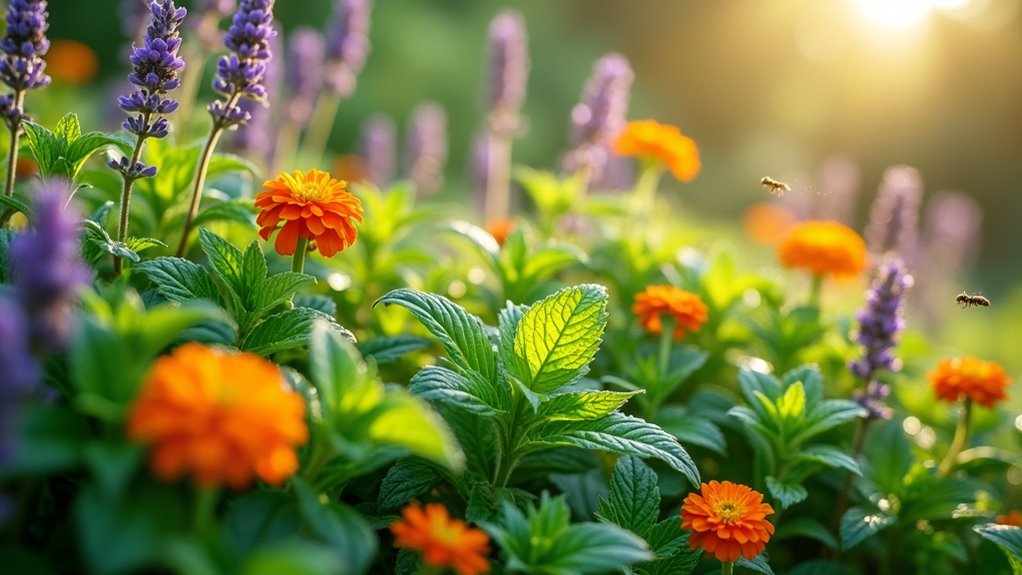
When you’re looking for natural ways to keep wasps at bay, understanding the science behind plant-based deterrents reveals why certain species work so effectively.
Chemical compounds in specific plants create powerful barriers that wasps can’t tolerate. Essential oils like citronellol and geraniol emit strong scents that disrupt wasps’ navigation and food detection abilities.
Plant-derived chemical compounds form natural defensive barriers by releasing potent essential oils that interfere with wasp sensory systems.
Aromatic herbs such as mint and basil release potent fragrances that mask food attractants, making your outdoor space less appealing to these insects.
Pyrethrins in chrysanthemums act as a natural insect repellent by disrupting wasp nervous systems.
Eucalyptol from eucalyptus provides deterrent properties through its intense menthol scent, while bitter compounds in wormwood repel wasps with aversive tastes and smells.
How Aromatic Scents Disrupt Wasp Navigation Systems
When you plant aromatic species around your outdoor areas, you’re fundamentally jamming wasps’ sophisticated navigation equipment with chemical compound interference.
These strong scents overwhelm their highly sensitive olfactory receptors, creating sensory overload effects that prevent them from processing normal environmental cues.
You’ll find that wasps can’t distinguish between communication pheromones and food source markers when these powerful plant compounds flood their sensory systems.
Chemical Compound Interference
While wasps possess remarkable hunting abilities, their greatest strength becomes their most exploitable weakness when you introduce the right aromatic plants into your outdoor space.
Chemical compounds like citronellol and geraniol directly target wasps’ olfactory receptors, creating confusion that disrupts their ability to navigate effectively. These aromatic scents don’t just smell pleasant to you—they actively interfere with the insects’ sophisticated navigation systems by masking vital pheromone trails wasps use for communication and orientation.
When you strategically place plants that release these plant volatiles, you’re fundamentally jamming the wasps’ sensory equipment.
The strong aromatic interference makes it difficult for them to locate food sources or return to their nests, naturally encouraging them to seek less confusing environments and helping you repel insects without harmful chemicals.
Sensory Overload Effects
Because wasps process thousands of scent molecules simultaneously to maintain their spatial awareness, introducing multiple aromatic plants creates a sensory bombardment that overwhelms their delicate olfactory system.
When you establish gardens with strong aromatic scents, you’ll create an environment where wasps can’t effectively communicate or navigate. This sensory overload disrupts their ability to process natural scents they rely on for survival.
Here’s how aromatic plants create sensory chaos for wasps:
- Multiple fragrance layers – Combining mint, lavender, and citronella creates competing scent signals.
- Communication breakdown – Overwhelming odors prevent wasps from detecting pheromone trails.
- Navigation confusion – Strong fragrances mask landmark scents wasps use for orientation.
- Territorial avoidance – Persistent aromatic barriers encourage wasps to seek calmer areas.
You’ll effectively repel these pests from your outdoor spaces through strategic sensory interference.
Lavender’s Dual Purpose as Beauty and Barrier
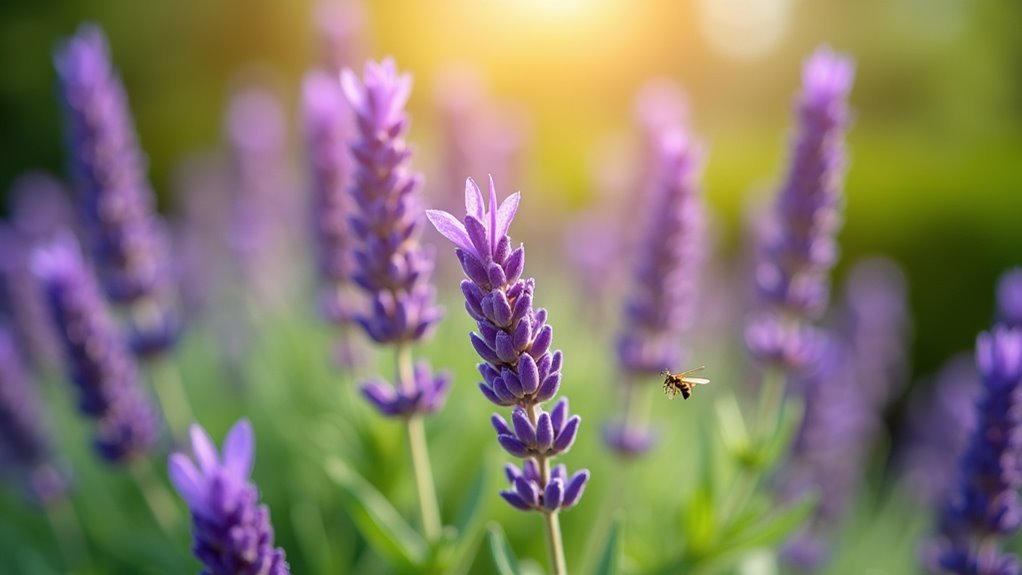
Though most garden additions serve either decorative or functional purposes, lavender delivers both benefits in one fragrant package.
You’ll get stunning purple blooms that enhance garden aesthetics while simultaneously deterring wasps with aromatic oils they can’t tolerate. This low-maintenance herb thrives in sunny, well-drained locations without demanding constant attention.
You’re creating a natural balance by attracting beneficial pollinators like bees and butterflies while keeping wasps at bay.
The plant’s dual nature means you won’t sacrifice beauty for function. You can extract lavender’s essential oils to create homemade repellent solutions for outdoor gatherings, extending protection beyond your garden borders.
Mint Varieties That Pack the Strongest Repelling Punch
Peppermint and spearmint stand out as the most powerful mint varieties for wasp deterrence, delivering concentrated aromatic oils that confuse and repel these unwanted visitors.
These mint varieties excel at repelling wasps through their strong scent and practical growing advantages:
- Peppermint reaches up to 3 feet tall and thrives in sunny to partially shaded locations, making it adaptable to various outdoor spaces where you need wasp protection.
- Spearmint offers a milder yet effective aroma that works well in wetter soil conditions, providing flexibility in garden placement.
- Container growing allows you to grow in pots, preventing aggressive spreading while keeping plants accessible near seating areas.
- Essential oils activation occurs when you crush the leaves, intensifying their repelling power while creating a revitalizing scent you’ll actually enjoy.
Eucalyptus Essential Oils as Natural Insect Shields
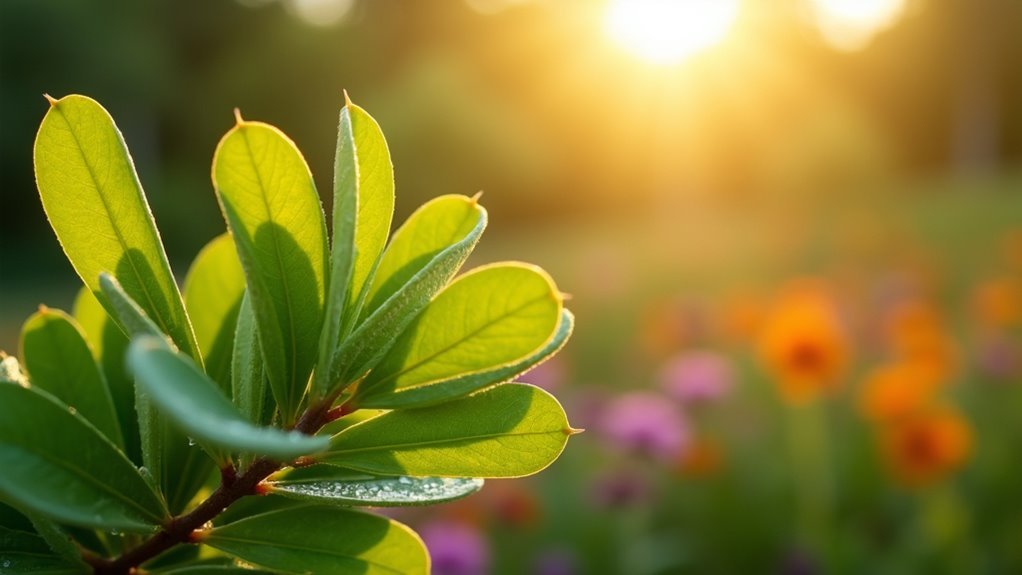
You’ll find eucalyptus essential oils create a powerful natural barrier against wasps through their strong menthol scent that confuses and repels these insects.
The oils work by releasing compounds like eucalyptol that wasps can’t tolerate, making them avoid treated areas entirely.
You can apply these oils in several outdoor methods, from direct plant placement to creating homemade sprays that protect your garden spaces.
Menthol Scent Properties
Eucalyptus essential oils pack a powerful menthol punch that wasps simply can’t tolerate. The menthol scent disrupts their olfactory receptors, making navigation extremely difficult. This natural pest deterrent offers effective pest control without harmful chemicals.
Here’s how eucalyptus leaves create exceptional insect-repelling properties to repel wasps:
- Olfactory Disruption – The menthol compounds interfere with wasps’ ability to detect food sources and locate ideal nesting spots in your outdoor spaces.
- Continuous Protection – Fast-growing eucalyptus trees provide year-round aromatic leaves that maintain their potent repelling effects throughout warm seasons.
- Natural Concentration – Fresh eucalyptus leaves release concentrated oils that create an invisible barrier wasps won’t cross.
- Dual Benefits – You’ll enjoy attractive foliage and vibrant scents while effectively deterring unwanted insects from your garden areas.
Application Methods Outdoors
Three proven application methods transform eucalyptus essential oils into powerful outdoor wasp deterrents for your property.
First, you’ll dilute the oils with water and spray them directly on patios, outdoor furniture, and entry points to establish a protective barrier against incoming wasps.
Second, you can grow eucalyptus plants throughout your garden, allowing them to continuously release their repellent properties into the air for ongoing protection.
Third, you’ll apply concentrated oil solutions to specific problem areas where wasps frequently gather. Regular reapplication enhances effectiveness since aromatic compounds dissipate over time.
These application methods for repelling wasps also provide additional benefits—the oils act as a natural antiseptic while creating invigorating scents in your outdoor areas.
Marigolds Beyond Decoration: Pest Protection Power
While most gardeners plant marigolds for their cheerful orange and yellow blooms, these hardy flowers pack a powerful punch against wasps through their distinctive spicy fragrance.
You’ll find that both French and American varieties effectively repel wasps, making them excellent natural pest control options for your gardens.
Here’s how marigolds maximize their wasp-deterring potential:
- Plant them in sunny locations where they’ll thrive and produce stronger scents
- Use as companion plants in vegetable gardens to protect your edible crops
- Deadhead regularly to promote continuous blooming throughout the growing season
- Position strategically around outdoor dining areas and garden borders for maximum protection
These low-maintenance flowers offer you an accessible, beautiful solution for managing wasp problems naturally.
Basil’s Culinary and Protective Garden Benefits
Beyond its reputation as a kitchen staple, basil serves as your garden’s dual-purpose powerhouse, delivering both culinary excellence and natural wasp protection. This versatile culinary herb emits a strong aroma that wasps particularly dislike, making it perfect for outdoor dining areas where you want to enjoy meals without unwanted buzzing guests.
| Garden Benefits | Practical Advantages |
|---|---|
| Natural wasp deterrent | Low-maintenance cultivation |
| Visually appealing foliage | Easy harvest promotes growth |
| Attracts beneficial pollinators | Thrives in warm, sunny conditions |
| Dual culinary/protective purpose | Aromatic oils released through harvesting |
You’ll find basil’s lush green leaves and small white flowers create an attractive garden display while actively working to repel wasps. Regular harvesting enhances both the plant’s growth and its pest-deterrent properties, making it an ideal choice for functional landscaping.
Wormwood’s Potent Aromatic Defense Mechanism
Though many plants offer modest wasp deterrence, wormwood delivers an exceptionally powerful aromatic punch that creates an almost impenetrable barrier against these unwanted insects.
This scientifically-named Artemisia produces a strong scent through potent aromatic oils that wasps find absolutely repulsive. When you brush against its distinctive silver, feathery foliage, it releases even more of its bitter aroma, strengthening your natural barrier against unwanted pests.
Here’s how to maximize wormwood’s wasp-repelling potential:
- Plant in sunny, well-draining locations where it’ll thrive and reach 2 feet tall
- Use containers for invasive control to prevent uncontrolled spreading throughout your garden
- Position strategically near outdoor seating to repel wasps from gathering areas
- Brush foliage occasionally to release maximum aromatic oils for enhanced protection
Citronella and Lemongrass Citrus-Based Repellent Properties
You’ll find citronella and lemongrass particularly effective against wasps due to their natural citronella oil content, which produces a strong citrus scent that disrupts the insects’ sensory receptors.
Both plants release potent aromas that create an invisible barrier around your outdoor spaces, with lemongrass offering especially concentrated repellent properties when you crush its leaves.
These hardy plants thrive in warm, sunny locations and adapt well to both container gardening and traditional garden beds, making them versatile additions to your wasp-deterrent strategy.
Natural Citronella Oil Properties
While many commercial repellents rely on harsh chemicals, citronella oil offers a natural alternative that’s proven effective against wasps. This powerful essential oil disrupts wasps’ sensory receptors, making it impossible for them to detect scents that normally attract them to your outdoor spaces.
The oil’s remarkable properties make it an excellent choice for repel strategies:
- Compound interference – Citronella oil’s active compounds mask attractive scents that draw wasps.
- Multi-insect effectiveness – You’ll repel various insects beyond just wasps with one solution.
- Enhanced potency – Crushing citronella leaves releases more concentrated oils for stronger deterrence.
- Easy cultivation – Planting citronella requires only sunny, warm conditions for ideal growth.
Lemongrass Scent Effectiveness
Lemongrass delivers one of nature’s most potent citrus-based defenses against wasps through its intensely aromatic compounds. When you plant this remarkable herb, you’ll harness citronella’s powerful insect-repelling properties that naturally disrupt wasp foraging behavior.
The plant’s strong citrus scent creates an invisible barrier that drives wasps away from treated areas, making it exceptional for natural pest control.
You’ll find lemongrass thrives in sunny environments, requiring minimal maintenance while providing maximum protection. For enhanced effectiveness, crush the leaves to release concentrated oils that amplify the repelling action.
This simple technique intensifies the aromatic defense system, creating wasp-free zones around patios, gardens, and outdoor living spaces where you want to enjoy peaceful, pest-free time.
Optimal Growing Conditions
Creating the perfect environment for citronella and lemongrass maximizes their wasp-repelling potential while guaranteeing robust plant health.
These ideal growing conditions transform your outdoor gardens into effective natural insect repellent zones.
- Sunlight Requirements: Position both citronella and lemongrass in warm, sunny locations where they’ll receive full sun exposure throughout the day for maximum oil production.
- Soil Preparation: Plant in well-drained soil to prevent root rot and guarantee proper nutrient absorption, which enhances their repellent properties.
- Planting Flexibility: Choose between garden beds or containers, as both options accommodate these versatile plants’ growth patterns effectively.
- Maintenance Schedule: Enjoy minimal maintenance requirements – simply water regularly and crush leaves occasionally to release their powerful citrus oils that deter wasps naturally.
Geranium’s Multi-Chemical Wasp Deterrent System
Among nature’s most sophisticated pest deterrents, geraniums deploy a complex arsenal of volatile compounds that effectively repel wasps through multiple chemical pathways.
Nature’s chemical warfare: geraniums unleash powerful volatile compounds that create an invisible wasp-repelling fortress through sophisticated molecular defense mechanisms.
When you plant these flowers in your garden, they’ll release citronellol, geraniol, and linalool—three powerful chemicals that insects find particularly offensive. This multi-layered scent barrier creates an invisible shield around your outdoor spaces that wasps instinctively avoid.
You’ll maximize these repellent properties by regularly brushing against the leaves or gently crushing them, which triggers increased volatile compound release.
The distinct fragrance that’s pleasant to humans proves highly effective at keeping wasps at bay while simultaneously attracting beneficial pollinators. This dual-action system makes geraniums an ideal choice for creating balanced, pest-free environments in any garden setting.
Strategic Plant Placement for Maximum Outdoor Protection
While understanding which plants repel wasps provides the foundation, proper placement transforms these natural deterrents into a thorough defense system for your outdoor spaces.
Strategic plant placement of plants that naturally deter wasps requires thoughtful positioning to keep wasps away effectively.
Here’s how to maximize scent dispersal and create a wasp-free environment:
- Position protective barriers – Place lavender, mint, and marigold near outdoor dining areas and patios to form natural boundaries against wasp intrusion.
- Scatter throughout your garden – Distribute repellent herbs across your landscape rather than clustering them to enhance fragrance coverage.
- Utilize vertical spaces – Install hanging baskets and wall planters to elevate scent distribution.
- Surround high-activity zones – Circle playgrounds and BBQ areas with deterrent plants to minimize encounters during gatherings.
Seasonal Growing Considerations for Year-Round Defense
Since wasps follow predictable seasonal patterns, you’ll need to time your planting schedule to guarantee your natural defenses peak when these pests become most problematic. Spring planting of repellent species like lavender and basil allows strong root establishment before wasps become active in late spring and summer.
| Season | Plant Focus | Wasp Behavior |
|---|---|---|
| Spring | Lavender, Basil, Mint | Low activity, establishing colonies |
| Summer | Marigolds, Geraniums | Peak activity, protein seeking |
| Late Summer | Continuous bloomers | Sugar craving increases |
| Fall/Winter | Perennial maintenance | Declining activity |
Choose perennial plants for year-round defense without replanting. Regular pruning and deadheading of geraniums and rosemary prolongs blooming periods. Incorporate seasonal varieties like lemongrass for warmer months and eucalyptus for cooler areas, creating diverse growing conditions that consistently deter wasps throughout the year.
Combining Multiple Plant Species for Enhanced Effectiveness
You’ll achieve better wasp deterrence by strategically combining multiple plant species rather than relying on single varieties.
When you pair aromatic herbs like mint and basil with flowering plants such as marigolds and chrysanthemums, you create overlapping scent profiles that confuse wasps’ sensitive olfactory systems.
This layered approach maximizes scent synergy, as the combined fragrances work together to create a more powerful repellent barrier than any individual plant could provide alone.
Strategic Plant Combinations
Although individual plants can deter wasps effectively, combining multiple species creates a powerful aromatic fortress that’s far more effective than relying on single varieties.
By mixing aromatic herbs and flowering plants with strong scents, you’ll establish strategic combinations that create a wasp-free environment around your outdoor spaces.
Here’s how to maximize your wasp-repellent plants:
- Layer complementary scents – Combine lavender, mint, and lemongrass to build an impenetrable aromatic barrier that overwhelms wasps’ senses.
- Create diverse plantings – Mix basil, rosemary, and thyme to confuse wasps with varying fragrances they can’t navigate through.
- Group overlapping properties – Pair marigolds with eucalyptus for strengthened deterrent effects while enhancing visual appeal.
- Utilize vertical spacing – Hang pots of pennyroyal and thyme to maximize scent dispersal throughout your deterrent to wasps garden design.
Maximizing Scent Synergy
When you layer different aromatic plants together, their unique chemical compounds interact to create a more powerful deterrent force than any single species could achieve alone.
This synergistic effect occurs when you combine strong scents from lavender, mint, and rosemary, confusing wasps and disrupting their ability to navigate toward food sources.
You’ll maximize effectiveness by selecting aromatic species with diverse scent profiles that complement each other.
Plant them in close proximity so their fragrances blend naturally, creating an enhanced repellent barrier.
Strategic placement around patios, dining areas, and entry points guarantees thorough coverage throughout your outdoor space.
The overlapping aromas work continuously, assuring that at least one scent remains active for deterring wasps during different times of day.
Maintenance Tips to Preserve Repelling Potency
Since repellent plants require proper care to maintain their wasp-deterring properties, you’ll need to establish a consistent maintenance routine.
These maintenance tips will guarantee your fragrant herbs and other repelling plants stay effective throughout the season.
- Prune and deadhead regularly – Trim marigolds and basil to encourage new growth and enhance their aromatic properties, maintaining ideal repelling potency against wasps.
- Water plants consistently – Guarantee proper hydration and well-drained soil, as healthy plants produce stronger scents that deter wasps more effectively than stressed specimens.
- Monitor signs of disease – Watch for pest infestations or plant illness that could weaken your natural barrier’s effectiveness.
- Replace annuals seasonally – Replant citronella and geraniums each year to maintain peak fragrance strength and repelling capabilities.
Frequently Asked Questions
What Outdoor Plants Keep Wasps Away?
You’ll find lavender, mint, marigolds, eucalyptus, and basil effectively repel wasps with their strong scents. Plant citronella and lemongrass in sunny spots too—they’ll create natural barriers that keep these pests away.
What Is the Best Wasp Repellent for Outdoors?
You’ll find citronella and lemongrass work best as outdoor wasp repellents. Their strong citrusy scents disrupt wasps’ food-finding abilities. Combine them with mint, lavender, or marigolds for maximum effectiveness.
What Do Wasps Hate the Most?
Wasps hate strong scents the most, especially from mint, basil, lavender, eucalyptus, and citronella. You’ll find they’re also repelled by marigolds and rosemary’s powerful fragrances that disorient them completely.
Do Marigolds Really Repel Wasps?
Yes, marigolds really do repel wasps effectively. You’ll find their strong, spicy scent naturally deters wasps from your garden areas. Plant French or American varieties around patios and vegetable gardens for best results.
In Summary
You’ve discovered nature’s powerful arsenal against wasps through strategic plant selection and placement. By combining lavender, mint, and eucalyptus in key outdoor areas, you’re creating an effective barrier that disrupts wasp navigation while enhancing your garden’s beauty. Remember to maintain these plants properly and consider seasonal growing patterns for year-round protection. With consistent care and smart positioning, you’ll enjoy wasp-free outdoor spaces naturally without harsh chemicals.

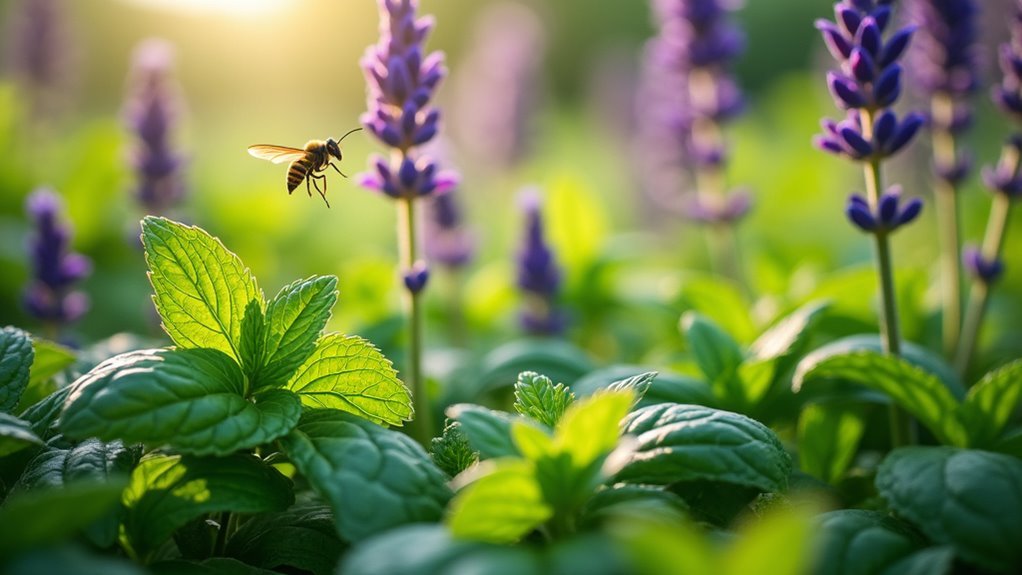


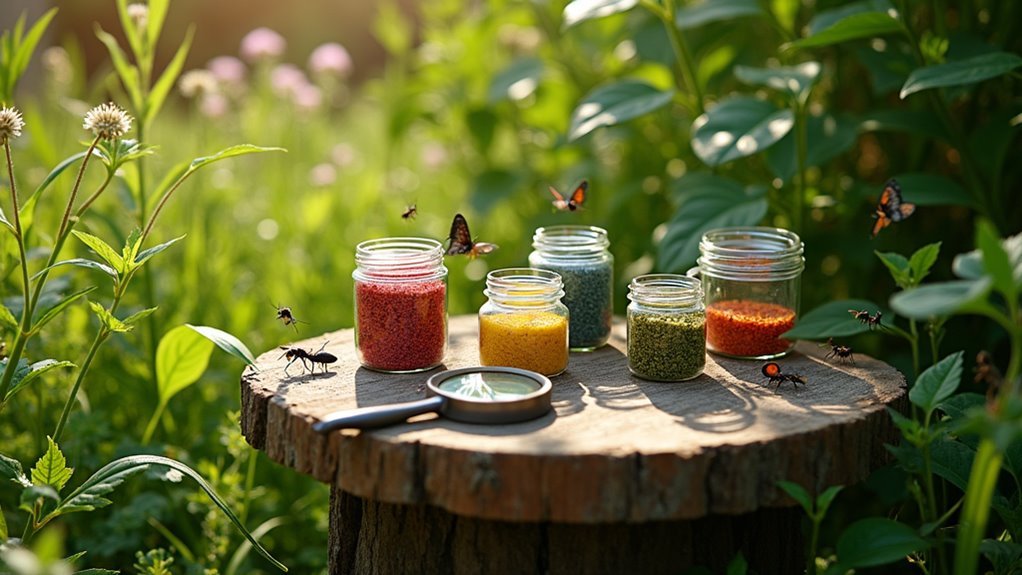
Leave a Reply